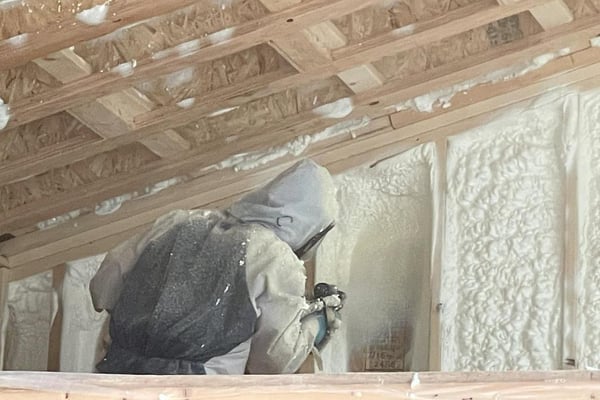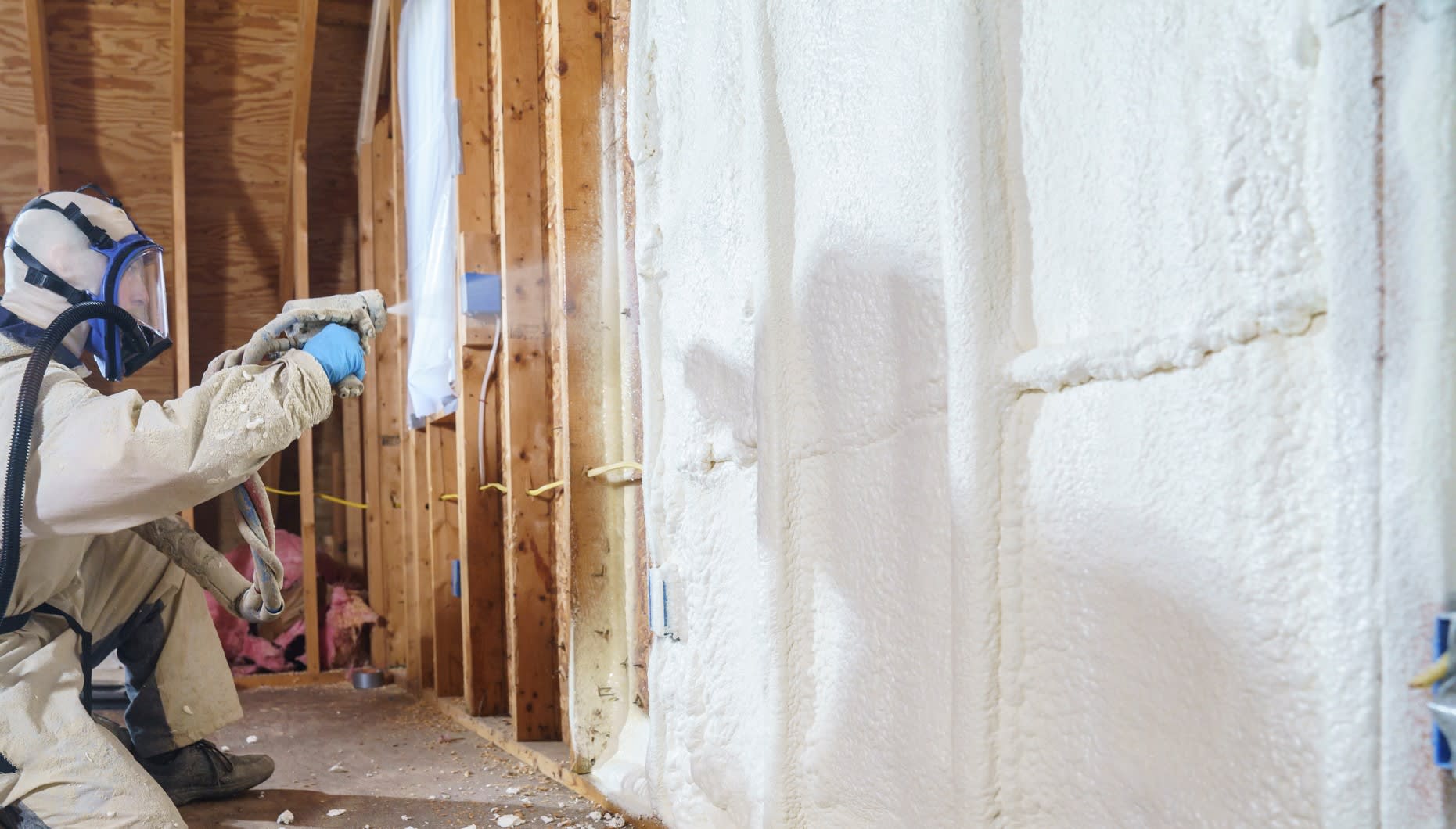The Environmental Impact of Spray Foam: Sustainability Considerations
Wiki Article
Spray Foam: The Ultimate Option for Air Sealing and Insulation
Spray foam insulation has actually arised as a leading remedy for effective air securing and thermal insulation, supplying a distinct mix of properties that set it apart from standard approaches. Understanding the complete extent of its benefits, installation procedures, and comparisons with other insulation types is important for making informed decisions.What Is Spray Foam?
Spray foam is a versatile insulation product that incorporates the concepts of air sealing and thermal resistance to boost power effectiveness in structures. Composed mostly of polyurethane or various other similar compounds, spray foam is applied as a fluid that expands upon call with surfaces, developing a solid, continuous layer of insulation. This unique residential property allows it to fill up voids, fractures, and voids that conventional insulation materials may ignore, giving a superior air seal.There are two main types of spray foam: open-cell and closed-cell. Open-cell spray foam is lighter and a lot more versatile, supplying excellent audio absorption and a reduced R-value per inch - Spray Foam. In contrast, closed-cell spray foam is denser, offering a higher R-value, dampness resistance, and added architectural integrity to constructing elements
The application process generally entails specialized equipment, making sure a seamless application that abides by various substrates, including steel, concrete, and timber. This adaptability makes spray foam suitable for both new building and constructions and retrofitting existing frameworks. Its capability to produce a closed obstacle dramatically adds to lowering power intake and improving interior air quality, thereby making it a preferred selection amongst home owners and building contractors alike.
Advantages of Spray Foam Insulation
Among one of the most significant benefits of spray foam insulation is its phenomenal capacity to develop a constant air obstacle, which effectively reduces energy loss. Unlike standard insulation products, spray foam broadens to fill up cracks and spaces, making certain that air leak is substantially minimized. This particular not just improves power effectiveness but likewise results in lower energy costs with time.
In addition, spray foam insulation gives premium thermal resistance, adding to a much more steady indoor environment. Its high R-value per inch permits reliable insulation in constrained areas, making it suitable for attics, walls, and crawl spaces. Additionally, the moisture-resistant residential or commercial properties of spray foam assistance prevent mold and mold development, promoting much healthier living problems.
Another crucial benefit of spray foam insulation is its sound-dampening qualities (Spray Foam). It successfully minimizes noise transmission in between spaces, producing a quieter and extra comfy home setting. The durability of spray foam additionally attracts attention, as it does not droop or clear up over time, preserving its performance throughout its lifespan
How Spray Foam Works
Understanding exactly how spray foam insulation works is essential for appreciating its effectiveness in air securing and thermal resistance. Spray foam insulation includes two main elements: isocyanate and polyol resin. When these parts are mixed, they go through a chemical reaction that creates the material to Related Site expand rapidly, producing a thick foam that loads cracks, tooth cavities, and voids.As the foam increases, it abides by surfaces, forming an impermeable seal that dramatically reduces air infiltration. This particular makes spray foam insulation very effective at stopping drafts and wetness infiltration, which can bring about power loss and damage over time. Furthermore, the closed-cell variation of spray foam uses superior thermal resistance because of its inflexible framework, effectively reducing warm transfer.
The one-of-a-kind properties of spray foam enable it to adapt uneven surface areas, making certain comprehensive coverage and a smooth barrier. Because of this, spray foam insulation not just improves power performance yet additionally adds to improved indoor air top quality by lowering the buildup of irritants and toxins. Inevitably, understanding the mechanics behind spray foam underscores its duty as an exceptional choice for insulation and air securing in both commercial and domestic applications.
Installment Process Summary

Prior to setup, the room should be sufficiently cleansed and prepped, guaranteeing that surface areas are free from dust, moisture, and debris. Due to the fact that contaminants can compromise bond and general efficiency, this action is critical. When the location is prepared, the application entails blending the two elements of the spray foam, which broadens upon call and loads voids properly.
Educated specialists must perform the installment, making use of specialized equipment to guarantee uniform coverage and ideal density. Safety and security precautions, including wearing safety gear and making sure appropriate ventilation, are important during this process. After application, the foam generally cures promptly, creating a strong barrier that improves energy efficiency.
Contrasting Spray Foam to Typical Insulation
When evaluating insulation alternatives, spray foam insulation stands out in contrast to standard materials such as fiberglass and cellulose. Unlike fiberglass and cellulose, which can allow air seepage, spray foam increases upon application, loading gaps and spaces to produce an airtight seal.Furthermore, spray foam offers a higher R-value per inch than typical insulation types, offering even more efficient thermal resistance in a thinner account. This particular is particularly helpful learn this here now in rooms with restricted dental caries depth. Spray foam is resistant to dampness and mold and mildew growth, which can be a considerable problem with cellulose and fiberglass, specifically in damp atmospheres.
Nonetheless, spray foam insulation normally carries a higher in advance expense than its conventional equivalents. House owners need to consider this preliminary financial investment versus long-lasting power cost savings and performance advantages. Ultimately, while both insulation you could try this out kinds serve their objective, spray foam becomes an extra innovative service for modern insulation requirements, particularly in regards to air securing and thermal performance.

Final Thought
In summary, spray foam insulation represents a very reliable service for achieving optimum air sealing and thermal resistance. Its distinct properties, consisting of moisture resistance and sound dampening, make it appropriate for numerous applications in both new buildings and retrofitting tasks (Spray Foam). Although the initial costs might be higher contrasted to typical insulation products, the lasting advantages, such as substantial energy cost savings and enhanced interior air quality, warrant the financial investment and underscore its value in modern building methods.Spray foam insulation has actually emerged as a leading option for efficient air securing and thermal insulation, using an one-of-a-kind mix of buildings that set it apart from traditional methods.Spray foam is a flexible insulation product that integrates the concepts of air securing and thermal resistance to improve power efficiency in structures.When evaluating insulation options, spray foam insulation stands out in contrast to typical products such as fiberglass and cellulose. Inevitably, while both insulation types serve their objective, spray foam arises as a much more sophisticated solution for modern-day insulation needs, specifically in terms of air sealing and thermal performance.
In summary, spray foam insulation stands for a very efficient remedy for accomplishing optimum air sealing and thermal resistance.
Report this wiki page